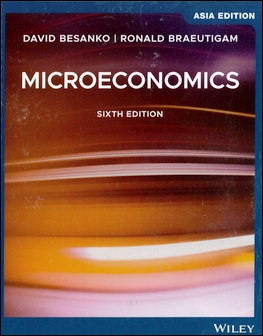(eBook) Microeconomics 6/e (需先報價)
- ◉ VitalSource
售價
$
洽詢
- 電子書
- ISBN:9781119554936
- 作者:David Besanko, Ronald Braeutigam
- 版次:6
- 年份:2020
- 出版商:John Wiley
- 頁數/規格:電子書
- 參考網頁:Microeconomics 6/e
書籍介紹
本書特色
目錄
►VitalSource 電子書購買須知:
Description
Microeconomics is a classroom-tested resource for learning the key concepts, essential tools, and applications of microeconomics. This leading textbook enables students to recognize and analyze significant data, patterns, and trends in real markets through its integrated, student-friendly approach to the subject — providing practice problems, hands-on exercises, illustrative examples, and engaging applications that ground theory firmly in the real world. Each chapter, opening with a set of clearly defined learning goals based on the Bloom Taxonomy, features numerous Learning-by-Doing (LBD) problems, mathematical and graphical data, and varied problem sets focused on current events.
Now in its sixth edition, the text offers extensive new and revised content throughout. All applications reflect current data and important new developments in the field of economics, including behavioral economics, randomized controlled trials (RCTs) in policy evaluation and design, and computational-based microeconomics. Updated chapter openers, designed to increase student interest, cover topics including the economic impacts of climate change, U.S. household income and spending, surge pricing by Uber and Lyft, the effect of immigration on wages, and advances in robotics, automation, artificial intelligence, and more.
- 閱讀期限:4年
- 電子書兌換碼將於 3-5 個工作天,寄送至「序號寄送 E-mail」所填寫的信箱。
- 根據消費者保護法第 19 條第 1 項規定,本產品為數位內容,售出後恕不接受退貨或退款。
- 本產品僅限台灣境內使用,海外 IP 無法註冊或啟用。
- 電子書平台登錄與註冊說明 (eText-Register.pdf)。
- 電子書平台操作手冊 (eText-Manual.pdf)。
- 如有任何問題,請 Email 至 ebook@tunghua.com.tw。
Description
Microeconomics is a classroom-tested resource for learning the key concepts, essential tools, and applications of microeconomics. This leading textbook enables students to recognize and analyze significant data, patterns, and trends in real markets through its integrated, student-friendly approach to the subject — providing practice problems, hands-on exercises, illustrative examples, and engaging applications that ground theory firmly in the real world. Each chapter, opening with a set of clearly defined learning goals based on the Bloom Taxonomy, features numerous Learning-by-Doing (LBD) problems, mathematical and graphical data, and varied problem sets focused on current events.
Now in its sixth edition, the text offers extensive new and revised content throughout. All applications reflect current data and important new developments in the field of economics, including behavioral economics, randomized controlled trials (RCTs) in policy evaluation and design, and computational-based microeconomics. Updated chapter openers, designed to increase student interest, cover topics including the economic impacts of climate change, U.S. household income and spending, surge pricing by Uber and Lyft, the effect of immigration on wages, and advances in robotics, automation, artificial intelligence, and more.
New to this Edition
Features
- Fresh and revised applications and chapter openers, including many focused on international microeconomics, technology, and the gig economy
- Revised end-of-chapter problems, data sets, graphs, and Learning-by-Doing (LBD) exercises
- Coverage of game theory/trade wars, computable general equilibrium models, and computational analysis in industrial organizations
- Case studies of Social Security, the production tax credit for wind power, and the Supplemental Nutrition Assistance Program (SNAP)
Features
- Presents a structured, integrated approach to microeconomic theory and analysis
- Offers step-by-step explanations and easy-to-use tables and graphs
- Contains numerous fully-worked practice problems with specific numbers and equations
- Provides alternative course designs for teaching microeconomics in a variety of formats and timeframes
- Includes complete teaching resources, such as an instructor’s manual, a solutions manual, a test bank, student quizzes and practice exams, and a study guide
- Features a companion website for both students and instructors that contains PowerPoint slides, Excel spreadsheets, and supplementary resources
- Available E-Text format includes clickable images, interactive tables and graphs, embedded practice quizzes, and audio-enhanced graphics
Table of Contents
PART 1 INTRODUCTION TO MICROECONOMICS
1. Analyzing Economic Problems
2. Demand and Supply Analysis
PART 2 CONSUMER THEORY
3. Consumer Preferences and the Concept of Utility
4. Consumer Choice
5. The Theory of Demand
PART 3 PRODUCTION AND COST THEORY
6. Inputs and Production Functions
7. Costs and Cost Minimization
8. Cost Curves
PART 4 PERFECT COMPETITION
9. Perfectly Competitive Markets
10. Competitive Markets: Applications
PART 5 MARKET POWER
11. Monopoly and Monopsony
12. Capturing Surplus
PART 6 IMPERFECT COMPETITION AND STRATEGIC BEHAVIOR
13. Market Structure and Competition
14. Game Theory and Strategic Behavior
PART 7 SPECIAL TOPICS
15. Risk and Information
16. General Equilibrium Theory
17. Externalities and Public Goods
Mathematical Appendix
Solutions to Selected Problems
Glossary
Index
PART 1 INTRODUCTION TO MICROECONOMICS
1. Analyzing Economic Problems
2. Demand and Supply Analysis
PART 2 CONSUMER THEORY
3. Consumer Preferences and the Concept of Utility
4. Consumer Choice
5. The Theory of Demand
PART 3 PRODUCTION AND COST THEORY
6. Inputs and Production Functions
7. Costs and Cost Minimization
8. Cost Curves
PART 4 PERFECT COMPETITION
9. Perfectly Competitive Markets
10. Competitive Markets: Applications
PART 5 MARKET POWER
11. Monopoly and Monopsony
12. Capturing Surplus
PART 6 IMPERFECT COMPETITION AND STRATEGIC BEHAVIOR
13. Market Structure and Competition
14. Game Theory and Strategic Behavior
PART 7 SPECIAL TOPICS
15. Risk and Information
16. General Equilibrium Theory
17. Externalities and Public Goods
Mathematical Appendix
Solutions to Selected Problems
Glossary
Index

